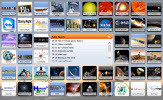December 2019
This month planet viewing noticeably decreases as the Sun catches up with the two giant outer planets, Jupiter and Saturn - net reult is that they set closer and closer to the time of sunset. This leaves the very bright shining inner planet Venus over the western horizon at sunset.
Turn to the morning skies to find the innermost planet Mercury gradually rising closer to sunrise - getting harder to see. Mars is visible but faint over the southeastern horizon at sunrise.
Click here for the month at a glance calendar.

The Winter Milky Way arches upward
past Betelgeuse in Orion and Capella in Auriga
Mercury will be visible in the morning skies where it will remain visible as a morning planet until toward the end of December when it moves to close to the Sun. Watch for Mercury to pass by the reddish star Antares toward the middle of the month.
Venus will be visible over the western horizon at sunset all month. Watch for conjunctions between Venus, the Moon, and Saturn.
Mars rises before sunrise local time and is visible, but faint, over the eastern horizon.
Dwarf Planet Ceres is too close to th eSun to be seen this month and for the next couple of months until it reappears rising ahead of the Sun over the eastern horizon.
Jupiter will be visible but low over the western horizon at sunset, and by mid-month will be too close to the Sun to be visible. Jupiter reappears in the morning skies in January.
Saturn like Jupiter is visible but low over the western horizon at sunset.










 Above the Solar System at 10 day Intervals
Above the Solar System at 10 day Intervals


